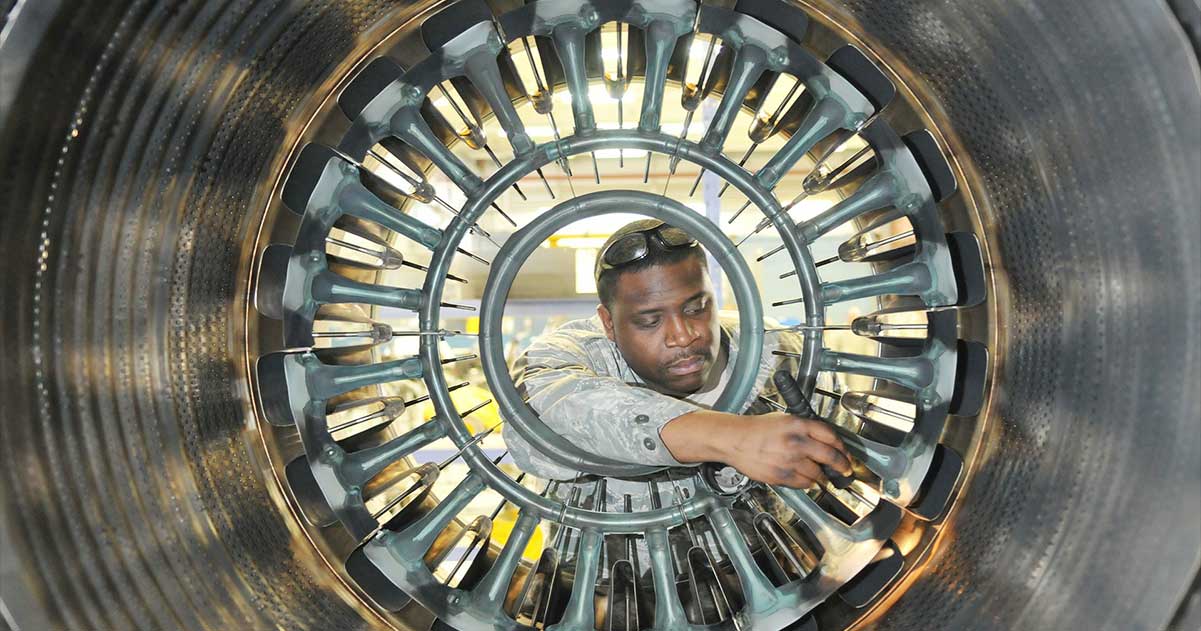Build Smarter Defense Operational Supply Chains With AM
By 2024, the worldwide market for 3D Printing and Additive Manufacturing in Aerospace and Defense is expected to grow at a CAGR of roughly 17.5%, exceeding $3.3 Billion USD. This growth is predominantly concentrated in the USA and Europe, however, parts of Asia-Pacific, the Middle East, and Africa are also increasing their adoption rates. The US Military has a proven preponderance of AM utilization for a variety of applications that include prototyping, R&D, MRO, and production parts. Due to their strict guidelines for repeatability, security, and time sensitivity, it’s no surprise that this industry is further pushing AM into mass adoption to solve the problems of today and tomorrow.
Introduction
Enhanced prototyping, research & development, customized jigs & fixtures, but also more and more, spare parts supply… Those of us who have lived within this industry are well aware of the applications and benefits that additive manufacturing provides. The defense industry is no different, but what makes their utilization so unique is also what will drive the next generation of manufacturing post-COVID-19. A recent article published by JABIL explains the value of manufacturing components on the fly in forward operating bases, and how engineers can succinctly repair equipment in the field and efficiently accomplish the mission without exorbitant costs or time lost. For most industries, time equals money — but in the military, time can be the difference between success and failure, and failure is not an option. The following article will outline the challenges that the defense industry is facing, examples from the US Navy, and how additive manufacturing and workflow software is the solution.
Challenges
For generations, the military has always been on the leading cusp of technological advancements that have positively impacted consumers and alternative industries. The microwave, digital photography, duct tape, and even the internet are examples of products born from research done for defense applications. Additive manufacturing is no different, and the early adoption approach by the military continues to push the industry forward. Let’s take a look at some of the current challenges and what the experts are predicting for the future of AM in the military and post COVID-19 manufacturing.
Reactivity:
The demand for near-the-battlefield production and agile manufacturing is a major priority for the US DoD and other civil protection agencies across the globe. With the recent influx in mobile labs and the need to reduce logistics and shipping costs, the military is heavily invested in technologies and workflows that can quickly react when called upon. Major benefits include the reduction of inventory and the ability to scale up production.
How does this impact Commercial Business?
COVID-19 is forcing companies to reconsider their operational environment. Working remotely will become widely accepted and warehouses and facilities will close as a byproduct of this cultural shift. The digital warehouse and flexibility to scale up production movement is happening. Specifically, we see this impacting the medical, consumer goods and packaging industries.
Repeatability:
General Gus Perna, the Head of Army Materiel Command, was recently quoted in an article with Defense News regarding the plans for additive manufacturing in tactical environments for the US Army. “I have to get the right machines. So I want machines out there that can fix what we call readiness drivers. Things that break down a lot so they can be done forward,” says Perna. This leads to an important consideration for all manufacturers, which is repeatability and quality of parts. While this puts pressure on OEM’s and material providers, it also provides a great opportunity for workflow software companies such as 3YOURMIND and the Agile MES software, built for aggregating and analyzing print and quality data.
How will this impact Commercial Business?
Raw materials for 3D printing will become more uniform and of a higher, more reliable quality. Thermoplastics, metals and hybrid composites are reaching qualification standards, and the data is more valuable than ever for specific industries such as aerospace and automotive.
Resilience:
COVID-19 is disrupting the global supply chain and manufacturers are identifying new ways to become self-reliant. For example, the US Army expects to obtain the intellectual property for repair parts in order to meet surge requirements and react accordingly on the battlefield. Although time is important, so is cost; in 2017 the US DoD spent approximately $1.194 billion on logistics operations. This indicates a significant push towards on-site and localized manufacturing of MRO and spare parts. The challenge to organize these technologies, materials, data, and part optimization is real and is currently being addressed.
How will this impact Commercial Business?
Reducing the impact of obsolescence and outdated tooling can be too much to manage for many manufacturers. Having reliable workflow software that can automatically present AM solutions can save a business time, money and simultaneously increase relationships with their customer base. The Agile ERP is a valuable solution for major industrial manufacturers such as Bosch and GKN.

Solutions
How does the military embrace agile production and the next generation of digital warehouses?
It starts by simplifying the AM ecosystem and identifying a workflow that centralizes data storage and improves inventory analysis. In addition, the military is highly interested in easy-to-use solutions that require minimal training due to the uniqueness of their complex situations and turnover rate. This requires simplified software solutions that enable non-expert controllers the ability to aggregate data and effectively communicate this to the multiple levels of stakeholders.
What are the resources that the military requires to produce reliable and repeatable results?
Like an architect designing a new building or a carpenter fixing a roof, this process requires a collection of tools to successfully complete the job. Data standardization, traceability, and continuity work in concert to provide quality assurance on technologies, materials, and job-specific parts. The military requires a software that prioritizes smart parts and has the ability to recommend custom workflows enabling automatic production. This streamlined process increases reliable and repeatable results while correctly estimating time and cost. It’s like an architect who knows exactly how long construction will take and the cost of materials — imagine that.
With the disruption to the global supply chain, what is the most cost-effective solution to reduce costs and improve efficiencies?
Surviving in the post-COVID-19 economy will require innovative, cost-cutting techniques. Military and commercial organizations will turn to artificial intelligence, robotics, and automation to eliminate confusion and bottlenecks in the order management process. Investing in software capabilities that can automatically compare technologies, materials, and resources from different facilities is the ideal distributed manufacturing network approach. This is highly beneficial for military FOBs and commercial organizations with more than one location.
Conclusion
COVID-19 is highlighting inefficiencies, production gaps, and bottlenecks for many organizations, especially those operating in the defense sector. Workflow software is one of the unique tools that aggregate, compare, and analyze the data to counter these issues. Ultimately, the goal for those operating in the military is to accomplish their mission as efficiently as possible, and the commercial world will be taking notes along the way. We are in unprecedented times, and it’s very likely that the early adopters of workflow software will be the ones leading us into the next generation of manufacturing.
For further information, watch the replay of the 3D FRIDAY TALK SHOW about "How is the defense sector using distributed manufacturing?"

